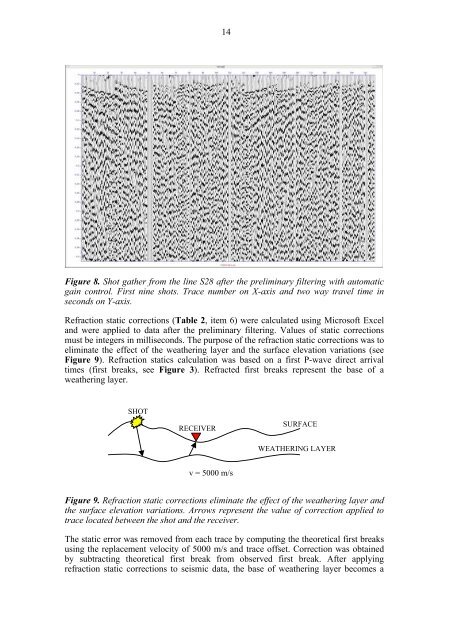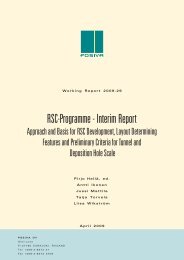Seismic 2D Reflection Processing and Interpretation of ... - Posiva
Seismic 2D Reflection Processing and Interpretation of ... - Posiva
Seismic 2D Reflection Processing and Interpretation of ... - Posiva
You also want an ePaper? Increase the reach of your titles
YUMPU automatically turns print PDFs into web optimized ePapers that Google loves.
14Figure 8. Shot gather from the line S28 after the preliminary filtering with automaticgain control. First nine shots. Trace number on X-axis <strong>and</strong> two way travel time inseconds on Y-axis.Refraction static corrections (Table 2, item 6) were calculated using Micros<strong>of</strong>t Excel<strong>and</strong> were applied to data after the preliminary filtering. Values <strong>of</strong> static correctionsmust be integers in milliseconds. The purpose <strong>of</strong> the refraction static corrections was toeliminate the effect <strong>of</strong> the weathering layer <strong>and</strong> the surface elevation variations (seeFigure 9). Refraction statics calculation was based on a first P-wave direct arrivaltimes (first breaks, see Figure 3). Refracted first breaks represent the base <strong>of</strong> aweathering layer.SHOTRECEIVERSURFACEWEATHERING LAYERv = 5000 m/sFigure 9. Refraction static corrections eliminate the effect <strong>of</strong> the weathering layer <strong>and</strong>the surface elevation variations. Arrows represent the value <strong>of</strong> correction applied totrace located between the shot <strong>and</strong> the receiver.The static error was removed from each trace by computing the theoretical first breaksusing the replacement velocity <strong>of</strong> 5000 m/s <strong>and</strong> trace <strong>of</strong>fset. Correction was obtainedby subtracting theoretical first break from observed first break. After applyingrefraction static corrections to seismic data, the base <strong>of</strong> weathering layer becomes a
















